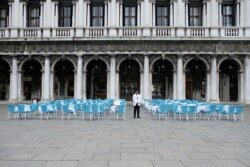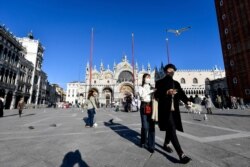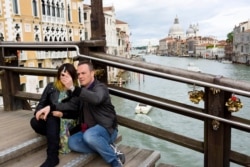The sight of Venice with the water in its empty canals clearer than I have ever seen, and with its unused gondolas lined up along its banks, will stay with me forever.
Everyone tries to visit this city at least once in their lifetime, bringing their children to see one of the world’s truly unique places. Personally, I have been to Venice many times but never thought I would have the opportunity to see it without tourists.
It is unimaginable to see this incredible city built on water without the millions of visitors that come from all corners of the world every year. They are normally everywhere along the narrow alleyways, or busy taking selfies on the Bridge of Sighs or in Saint Mark’s Square.
For the past two months, because of the very strict lockdown in Italy due to COVID-19, this has been the new reality in Venice, and one that is likely to continue for many weeks to come.
The big cruise ships that Venetians have complained about for years are unlikely to re-appear anytime soon. Italians from outside the Veneto region will probably be the first to come back to admire and appreciate the lagoon city in a very different way.
Personally, I had a beautiful and unforgettable experience last week as local authorities began to ease the lockdown and I was able to see the city being enjoyed by no one but the Venetians themselves in their protective masks.
Venetians are used to wearing a very different type of mask during the Carnival month, which is one of the most famous in the world.
On the night of Feb. 21, I was at the Doge’s Ball -- the Venice Carnival’s most famous party, attended by many of the city’s authorities including the mayor. That was the day the Veneto region suffered its first victim from Covid-19, leading quickly to the abrupt cancellation of the remaining Venice Carnival events.
Over the years, the population of Venice has dropped steadily as many Venetians moved out of the city and sold their homes, most of which were turned to the tourist trade. Bed-and-breakfasts flourished. But like the hotels in this city, they are now closed and many have come to realize that no city can survive on tourism alone.
Every aspect of the economy is suffering, including public transport and its well-known ferries or “vaporetti,” which have until now had different fares for residents and for visitors.
The “vaporetti” were the only means of transportation in Venice that continued through the lockdown, although the normally packed vessels were nearly empty -- another sight that will be hard for me to forget.
That is not to mention the empty train station -- Venice Santa Lucia -- where streams of suitcase-toting tourists normally line up to board the waiting water taxis that take them to their local accommodations.
As I walk around Venice I admire its remarkable beauty: From Saint Mark’s Square I can see the majestic church of Santa Maria della Salute on the other side of the Grand Canal.
I think of the history of this particular church, and how many Venetians will want to go back inside to attend mass as soon as church services are re-opened to the public, to pray for an end to these difficult times.
Nearly four centuries ago, in 1630, one-third of the population died when a wave of the plague assaulted Venice. That year, the Venetian Senate decreed the construction of a new church dedicated to Our Lady of Health, or Salute in Italian, the protector of the Venetian Republic.
My thoughts also turn to the word quarantine, which has been on everybody’s mouth since the start of the coronavirus outbreak. Quarantine comes from the word “quarantena” in Italian, meaning 40 days.
The word was first used by the Venetians in the 14th and 15th centuries – the time of the Black Plague -- when the city was the commercial crossroads of Europe. For Venetians, “quarantena” was the period that all ships, along with their passengers and crew, were required to isolate before they could come ashore.
Venetians have had a tough several months beginning with record floods in November, which hit the tourism industry hard. Coronavirus dealt a further blow. But like its famous theater, La Fenice, which rose from its ashes after a devastating fire, Venetians are certain the city will be return to its ancient glory.








